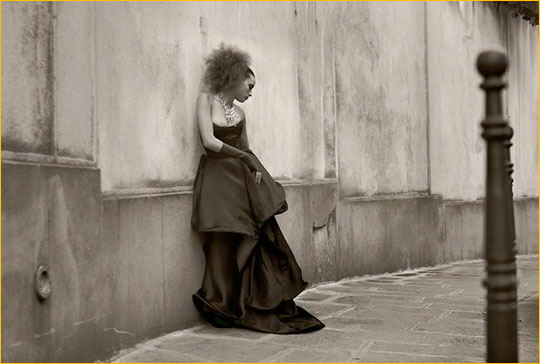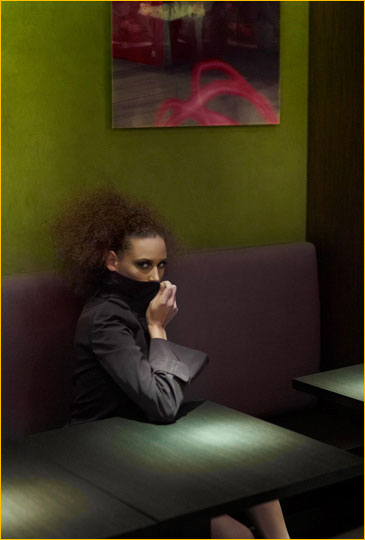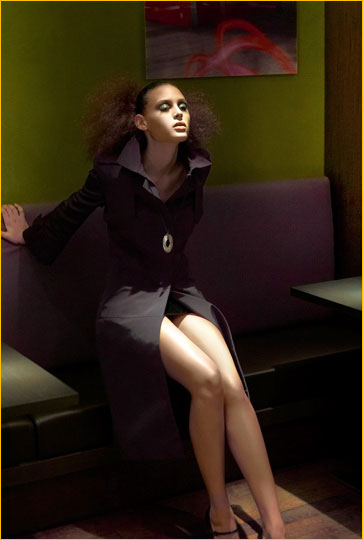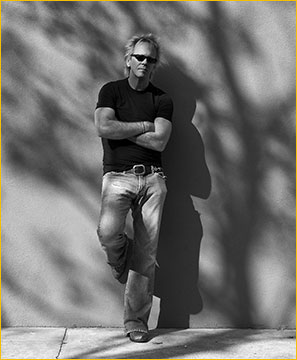
The Purchase
I’m not a range finder guy.
In fact for my entire career, other than hold somebody’s point and shoot at a party, I’ve never shot a frame of film or digital with a rangefinder camera.
I just didn’t see the point of looking through one window, focusing, then composing with little lines and then shooting through a lens that is probably not near the composition you intended.
Given this, for the last year or so I’ve longed for the Leica M8.
When I have a few hours break my favorite place to go is the Leica Gallery on Broadway. It’s a quick 5 minute walk from our studio and going in there just clears my head of downloads, clients, promos, agents, e-mails and takes me back to simpler times where a photograph was just a subject, background and light.
No overt manipulation, color correction or weeks of post production. Just shoot, print and ship.
The Leica Gallery has one other attraction for me in the fact it has my photo school in one of it’s glass cases.
When I was a young art director I learned photography from the Leica Manual, (the big silver covered one that is about the size of a phone book).
I would check that book out from the library every two weeks until I was the only name on the library card. I knew all the librarians by name. They were so used to my routine of returning the book, then coming back two days later that they usually kept it in the front waiting for me.

One day, I went in to resume my studies and someone had checked it out ahead of me and it stunned me. It was like showing up to school and finding the doors locked.
So in a way I have a history with Leica, though I’ve never owned one of their cameras.
Anyway, a few months ago I was finally sucked into the world of Leica. I was at the gallery and walked a few steps over to Kurland and bought a new black M-8.
I also bought a 50, a 28 and a 90 elmarit. First thing I noticed is how physically beautiful the lenses are. They’re more like fine jewelry than a mechanical tool.
After you hold those lenses I was just in love, of course until then you ask "how much" and it’s like walking into Capo and the menu says Kobe Beef burger … $35, you think "Can a hamburger really be worth $35?".
So I returned the 50 and bought a Voigtlander 50 1.2 and a 35mm 1.4. (more on this later).
____________________________________________________________________________________
Retraining
For me shooting the Leica was like retraining myself in photography. What I thought was in focus was not, what I thought I had framed perfectly was off, what I thought would produce no noise did, what I thought would produce a lot of noise really didn’t.
Shooting the Leica is like going out with Pamela Anderson. The camera keeps saying you can make me clean, cook, raise the kids, but I won’t be very good at it., though if you let me do what I’m good at you’ll be very happy.
So that’s what the Leica does, only what it wants to do and I can’t quantify or specifically say what it does, other than it makes me very happy.
50% of everything I shoot with it is not in real tack focus, 50% has too much noise, 50% has surprise framing, but no camera I have ever used has touched me so deeply. I just can’t really explain it but I know that if I keep down this path I’ll probably spend my life savings on lenses.
Focusing is the biggest issue. It’s just a surprise at anything more open than 5.6 and I know some Leicafistas (is that a word?) will jump all over this and show me twenty five in focus shots of walls, I can honestly say that focusing the Leica is similar to riding a skateboard down a hill and trying to eat ice cream. There is a lot of variables, but you know it doesn’t bother me that much because something about the leica glass, or something about the build of the camera, the closeness of the lenses, the way you interact with the frame just makes all the other stuff go away.
It’s like every time I shoot something with the Leica it produces a look of history or better put the photograph looks like it should have historical merit.
I know, that’s a reach and I can’t explain it, but that’s how I feel after I’ve shot with it.

As far as the Voigtlanders. They’re good lenses, seem sharp (insert a laugh here) but they are not near the build quality of feel of the Leica’s so I’m back to being a Leica junky and buying glass.
A friend of mine says that buying a Leica and putting Voigtlanders on it is like buying a Porsche and dropping in a Chevrolet engine and he’s right.
The menu is a mess and it’s functions make no logical sense, but it is so simple and MS DOS looking that I learned it in about 10 minutes.
The lcd is good, especially on black and white (where I think it should be set for all time), the auto white balance is a riot, as you never know what color it’s going to produce, but in C-1 pro which works very well with the Leica dng files, all the colors clean up and you can move the file around where you want.
The Leica tethering software is absolutely hilarious in the fact the Leica logo is as big as the preview (though you can tether to C-1 using a hot folder) and quite honestly this isn’t a camera that is really made for tethering.
____________________________________________________________________________________
On The Road
I finally had the chance to use the Lecia on a recent swing through Spain and France.
I was commissioned to shoot Ronaldinho in Barcelona and Lyon andan editorial fashion spread in Paris.
For the sports work I shot 99% with the D-3, and about 2% with the Leica and for the editorial about 80% with the Canons, and the rest with the Leica, though everyone of those Leica images I find special.
So in conclusion if you want a digital camera that you can pixel peep until your eyes bleed, or can auto focus and shoot 90 frames a second, this isn’t the one.
But and I guess this is the lure of the Leica, if you want to shoot something that takes thought and brings us back to where photography use to be then this is the camera.
I hear rumors (nothing from the inside) that Leica has new cameras on the way and I guess that’s good, though in reality if they made an M8 that had 20mpx, I don’t think it would matter one bit and I probably wouldn’t rush out and buy the newest, the latest, the greatest.
This isn’t a camera you compare to anything, because there is no other high quality rangefinder digital. I guess someday Nikon or Canon will make one that will probably better the Leica in all aspects, except one, that is it’s a Leica.
It comes with all that history attached, the Leica gallery, the thousands of historic photos and though I believe that photography has to move forward I also believe that some things of the past just worked so well that they are hard to improve upon.
Then again if Leica found some way to make the thing auto focus or at least "easy" focus I’d probably buy it in a heartbeat.
I have another friend whose work I admire greatly that owns about every Leica lens on the planet. He loves photography and for me has been very special to talk to because he doesn’t shoot for a living, he shoots for his passion. Like me he screams at the top of his lungs (and this guy has some amazing lungs) that he would give anything if the camera focused easier, but then again he still picks it up, still suffers through it, still busts his tail trying to produce that perfect shot with a mix of 1940 and 2007 technology. That’s pretty cool.
That is what Leica is about.
____________________________________________________________________________________
No Peeping

Of the images shown some have a lot of post work, some have very little, but don’t try to pixel compare these because with this camera, that really doesn’t matter.
Actually I doubt if it matters with any camera.
On all the forums everybody is busting each other’s b***’s trying to prove their Mark 7 dslr is just as good as the L-99 digital back, or vice versa.
That’s fine for camera salesman and camera reps who have an honest agenda to move product, but my goal is not to sell cameras, it’s photography.
There is a difference in how a camera or a camera/back allows you to work and they all have their place, though how we feel about our tools is just as important as how we interact with a subject.
Digital has changed the way we work and the expense of the systems has changed the way we invest in our cameras. It seems everyone wants a do it all system, probably because Canon came out so good, so fast with a digital camera and in so many ways the Canons and the New Nikons cover a lot of territory. You can see medium format going the same way. Some of this is good, but nothing is better than options.
Still, even though I would be limited in my profession if I could only shoot my P30, or my Canons, or my Nikons, there really is room in my work for this quirky little Leica.
I love cameras that are strange and force me to see the world just a little bit differently than I did yesterday, because that’s what photography is all about, seeing the world just a little bit differently.
December, 2007
____________________________________________________________________________________
ADDENDUM
Focus?
When I wrote this little article on the Leica and sent it to Michael I titled it a "Non Review", because I’m not a camera reviewer, not a professional writer. I’m a photographer and the only reason I spent time on this was to share the experience of first time Leica ownership.
The responses that come from this type of communication, fascinate me.
First the internet bloggers picks it up in minutes there are 4 google pages under the heading James Russell, Leica.
That truly amazes me. The second thing is how personal people take these articles.
The nice result is I received some really wonderful responses from people that were also affected in a positive way by using the Leica and photography.
The two articles I’ve written for Michael’s site have been very rewarding. I’ve rekindled old relationships and made some new ones.
From the Leica piece, I’ve received responses from the unknown to the famous and though I respect their desire for anonymity it’s wonderful to receive e-mail from people that love the photograph and find something special about this little camera. One person who is a very high profile entertainer, shoots beautiful work with the Leica (and many other cameras) and he could easily leverage his combination of talent and celebrity into gaining attention.
To me he is the consummate Leicafista (once again, is that a word?) because he talks photography, loves photography and moves his photographs to higher levels.
Unlike so many in the world, he is not trying to improve upon his popular status.
This is what the Leica is about and I believe who this camera is made for.
Then of course there is the flip side, some of it humorous, some ugly.
Like Michael, I have a pretty thick skin so most of this just rolls off of me, though I have to admit that seeing a headline, Photographer Can’t Focus, was somewhat of a surprise.
I laughed on that one, though I find the things people want to comment on, out of context, to be strange. You see it in the forums all the time, it seems some just wait for that one phrase or word they can use to validate their opinion, purchase, non purchase, likes, dislikes, etc.
Honestly I don’t really know what any of this has to do with cameras, or photography, especially the Leica.
Some cameras work for some people, some cameras don’t though comparing a Leica to an all auto dslr is like comparing a meal at Wendy’s to DB Bistro. They both serve good food, they both will sustain you, but there is a big difference in the presentation, investment, style and enjoyment.
Some of this reaction I put on myself because I left out how I work with most of my subjects, especially models. I don’t have this predisposed idea that forces a model into one pose. I go into each day with a broad plan, but my role is to take what the model’s/subjects gives me and expand upon it.
I don’t shoot chairs, walls, or ketchup bottles, I shoot people, and they are all different and react to direction in their own unique way, which means they move at will, and with these girls they move a lot, to the point that one frame is rarely anywhere close to the same focusing distance as the previous frame.
Model’s of this level are artists in their own right, and locking them down to one single pose or idea is wrong. They move, they bend, they express, they inspire me and the rest of the crew into seeing things that any pre determined plan could not imagine.
The upside is every frame is unique and if done right, captures the humanity of the subjects, the downside is, you never know where they’re going, so focus with any camera can be a surprise, especially with low light and wide open lenses.
Even the best, fastest auto-focus, the biggest brightest viewfinder can be thrown when a model quickly moves back 6", or worse 2.5".
Then again that’s what makes a photo unique, the humanity that everyone in the room brings to the final process and the final result.
Once again this emphasis on focus throws me. There are so many wonderful things about this little camera, (including taking the bottom off to load a card) that shooting manual focus and accepting that with longer lenses and wide open f stops there will be some softer looks, but I’ve always believed that tack sharp uber focus is highly overrated for a lot of imagery.
Go into any Gallery that has the work of the past masters and I think you’ll be surprised at how many great photographs are not tack sharp.
A friend and photographer whose work I admire greatly and one of the true masters of our art, Melvin Sokolsky says quite emphatically that he has seen few great photographs completely in focus.
(Let’s don’t pick up that Mr. Sokolsky doesn’t like in focus photographs, because that is not the intent or reason for this quote).
Personally, I think digital capture has and will continue to add to the art of photography, except for the obsession people have developed of peering into images at 200% to check for slight abnormalities.
I think this is why Michael continually stresses how an image looks on a print, vs. how it looks on an lcd display.
Now, since owning the Leica I’ve wondered why I believe the images look different than other 35mm images and for me (let me say this again . . . for me), I believe that a lot of this comes from not looking through the lens.
As small and mobile as a Leica is, I find that it is a camera for making photographs, not taking pictures. You don’t look through the lens, so what you see is real life, minus the falloff, compression, bending, curving, etc. of the lens. You see the photograph as much in your mind as you do in the physical sense and then once framed, once the button is pushed, the camera translates that real life look into a photograph and for me it’s always just slightly different than what I imagined.
All of this I find to be positive. It’s nice to take even a few extra milliseconds and think about the photograph.
So my point of this addendum, is not to defend the Leica, or myself, but to give a little more insight into how I think this camera forces me and others to think about the photograph.
I think we are all fortunate that the Leica even exists, especially in this age where everyone has a 6mp capture device embedded in their phone. I also think for any aspiring photographer, this is a great tool to learn with, as it makes you work, makes you think about the photograph in a thoughtful, respectful manner, than no auto everything camera will.
I’ll end this with a quote from Mr. Sokolsky that I think we all can learn from;
"I started looking at things more closely. I soon realized that when I looked at things, I saw them one way, but when I closed my eyes i saw other things. I wondered if it was possible to put these other things on film."
____________________________________________________________________________________

James Russellis one of the world’s leading commercial photographers,
with offices and studios in New York, Los Angeles and Dallas.
